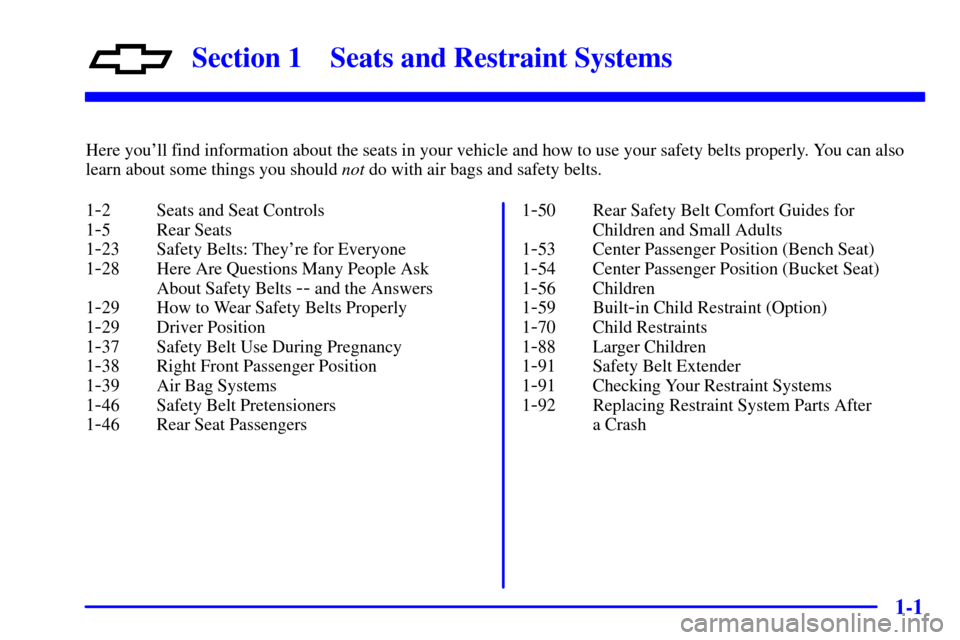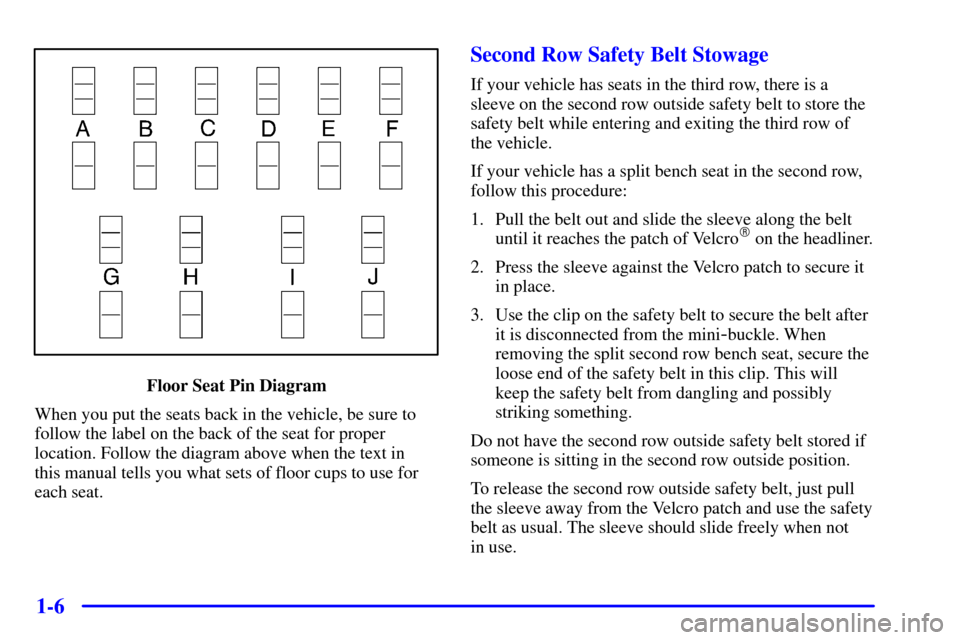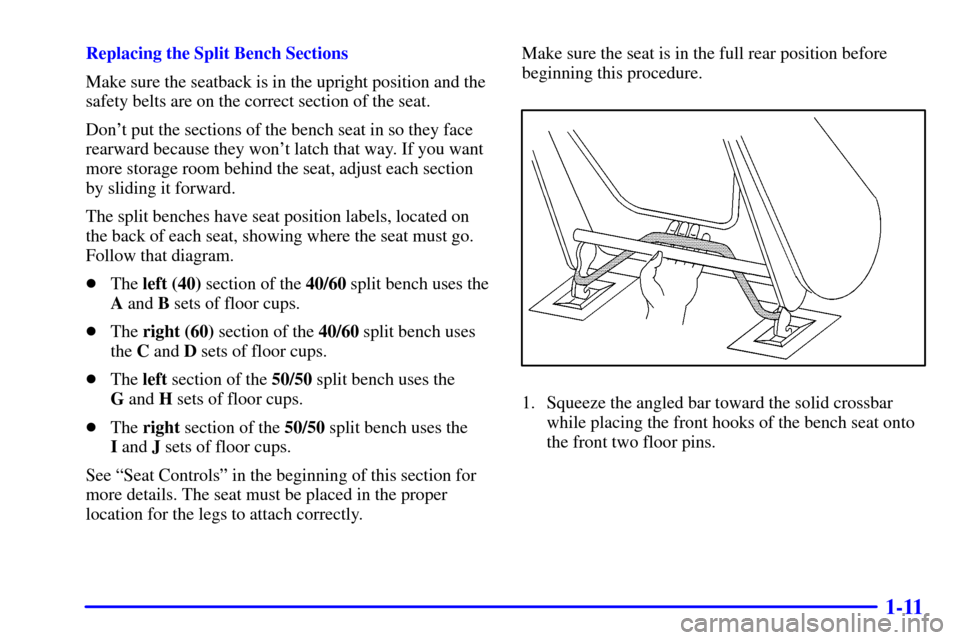Page 4 of 429
Table of Contents
Keys and Door Locks
Keyless Entry System (Option)
Automatic Transaxle
Parking Brake
Windows
Tilt Wheel
Turn Signal/Multifunction Lever
Windshield Wipers
Cruise Control (Option)Interior and Exterior Lamps
Mirrors
Storage Compartments
Convenience Net (Option)
Accessory Power Outlets
OnStar® System (If Equipped)
Instrument Panel, Warning Lights and Gages
Driver Information Center (Option) Seats and Seat Controls
Safety BeltsAir Bag Systems
Child Restraints
Section
1
Section
2
Seats and Restraint Systems
Features and Controls
ii
Page 11 of 429
ix
For example,
these symbols
are used on an
original battery:
CAUTION
POSSIBLE
INJURY
PROTECT
EYES BY
SHIELDING
CAUSTIC
BATTERY
ACID COULD
CAUSE
BURNS
AVOID
SPARKS OR
FLAMES
SPARK OR
FLAME
COULD
EXPLODE
BATTERY
These symbols
are important
for you and
your passengers
whenever your
vehicle is
driven:
DOOR LOCK
UNLOCK
FASTEN
SEAT
BELTS
POWER
WINDOW
AIR BAG
These symbols
have to do with
your lamps:
MASTER
LIGHTING
SWITCH
TURN
SIGNALS
PARKING
LAMPS
HAZARD
WARNING
FLASHER
DAYTIME
RUNNING
LAMPS
FOG LAMPS
These symbols
are on some of
your controls:
WINDSHIELD
WIPER
WINDSHIELD
WASHER
WINDSHIELD
DEFROSTER
REAR
WINDOW
DEFOGGER
VENTILATING
FAN
These symbols
are used on
warning and
indicator lights:
ENGINE
COOLANT
TEMP
BATTERY
CHARGING
SYSTEM
BRAKE
COOLANT
ENGINE OIL
PRESSURE
ANTI-LOCK
BRAKES
Here are some
other symbols
you may see:
FUSE
LIGHTER
HORN
SPEAKER
FUEL
Vehicle Symbols
These are some of the symbols you may find on your vehicle.
Page 13 of 429

1-
1-1
Section 1 Seats and Restraint Systems
Here you'll find information about the seats in your vehicle and how to use your safety belts properly. You can also
learn about some things you should not do with air bags and safety belts.
1
-2 Seats and Seat Controls
1
-5 Rear Seats
1
-23 Safety Belts: They're for Everyone
1
-28 Here Are Questions Many People Ask
About Safety Belts
-- and the Answers
1
-29 How to Wear Safety Belts Properly
1
-29 Driver Position
1
-37 Safety Belt Use During Pregnancy
1
-38 Right Front Passenger Position
1
-39 Air Bag Systems
1
-46 Safety Belt Pretensioners
1
-46 Rear Seat Passengers1
-50 Rear Safety Belt Comfort Guides for
Children and Small Adults
1
-53 Center Passenger Position (Bench Seat)
1
-54 Center Passenger Position (Bucket Seat)
1
-56 Children
1
-59 Built-in Child Restraint (Option)
1
-70 Child Restraints
1
-88 Larger Children
1
-91 Safety Belt Extender
1
-91 Checking Your Restraint Systems
1
-92 Replacing Restraint System Parts After
a Crash
Page 17 of 429

1-5
CAUTION:
Sitting in a reclined position when your vehicle is
in motion can be dangerous. Even if you buckle
up, your safety belts can't do their job when
you're reclined like this.
The shoulder belt can't do its job because it
won't be against your body. Instead, it will be in
front of you. In a crash you could go into it,
receiving neck or other injuries.
The lap belt can't do its job either. In a crash the
belt could go up over your abdomen. The belt
forces would be there, not at your pelvic bones.
This could cause serious internal injuries.
For proper protection when the vehicle is in
motion, have the seatback upright. Then sit
well back in the seat and wear your safety
belt properly.
Head Restraints
Head restraints are fixed on some models and adjustable
on others. Slide an adjustable head restraint up or down
so that the top of the restraint is closest to the top of
your ears. This position reduces the chance of a neck
injury in a crash.
Rear Seats
Seat Controls
The rear seats in your vehicle have levers and straps
used to adjust, remove and reinstall the seats. By using
the levers and straps, in the correct order, you can easily
remove the seats from your vehicle.
Page 18 of 429

1-6
Floor Seat Pin Diagram
When you put the seats back in the vehicle, be sure to
follow the label on the back of the seat for proper
location. Follow the diagram above when the text in
this manual tells you what sets of floor cups to use for
each seat.
Second Row Safety Belt Stowage
If your vehicle has seats in the third row, there is a
sleeve on the second row outside safety belt to store the
safety belt while entering and exiting the third row of
the vehicle.
If your vehicle has a split bench seat in the second row,
follow this procedure:
1. Pull the belt out and slide the sleeve along the belt
until it reaches the patch of Velcro
� on the headliner.
2. Press the sleeve against the Velcro patch to secure it
in place.
3. Use the clip on the safety belt to secure the belt after
it is disconnected from the mini
-buckle. When
removing the split second row bench seat, secure the
loose end of the safety belt in this clip. This will
keep the safety belt from dangling and possibly
striking something.
Do not have the second row outside safety belt stored if
someone is sitting in the second row outside position.
To release the second row outside safety belt, just pull
the sleeve away from the Velcro patch and use the safety
belt as usual. The sleeve should slide freely when not
in use.
Page 21 of 429
1-9
The other lever is located on
the rear of the seat.
Lift up either lever and slide the seat forward to allow
for extra storage behind the seat, or slide the seat back to
allow extra room for passengers.
Release the lever. Push and pull on the seat to be sure it
is locked into place.Removing the Split Bench Seat
Make sure the seatback is in the upright position.
1. For the second row split bench, with the seatback in
the upright position, unhook the side attachment for
the safety belt. This mini
-buckle is located on the
right side of the seat.
2. Push the red center
of the buckle up
with a small pointed
object
-- like a key or a
pen to remove the seat
belt, if needed.
3. Lift the seatback recliner lever or pull the nylon strap
on the back of the seat to fold the seatback forward.
4. Slide the seat all the way back by lifting either one
of the adjustment bars and sliding the seat
fully rearward.
Page 23 of 429

1-11
Replacing the Split Bench Sections
Make sure the seatback is in the upright position and the
safety belts are on the correct section of the seat.
Don't put the sections of the bench seat in so they face
rearward because they won't latch that way. If you want
more storage room behind the seat, adjust each section
by sliding it forward.
The split benches have seat position labels, located on
the back of each seat, showing where the seat must go.
Follow that diagram.
�The left (40) section of the 40/60 split bench uses the
A and B sets of floor cups.
�The right (60) section of the 40/60 split bench uses
the C and D sets of floor cups.
�The left section of the 50/50 split bench uses the
G and H sets of floor cups.
�The right section of the 50/50 split bench uses the
I and J sets of floor cups.
See ªSeat Controlsº in the beginning of this section for
more details. The seat must be placed in the proper
location for the legs to attach correctly.Make sure the seat is in the full rear position before
beginning this procedure.
1. Squeeze the angled bar toward the solid crossbar
while placing the front hooks of the bench seat onto
the front two floor pins.
Page 25 of 429

1-13
CAUTION:
A seat that isn't locked into place properly can
move around in a collision or sudden stop. People
in the vehicle could be injured. Be sure to lock
the seat into place properly when installing it.
5. Lift the seatback recliner lever or pull the nylon strap
on the back of the seat and raise the seatback until it
locks upright.
6. Push and pull on the seatback to check that it
is locked.
CAUTION:
If the seatback isn't locked, it could move
forward in a sudden stop or crash. That could
cause injury to the person sitting there. Always
press rearward on the seatback to be sure it
is locked.
7. Attach the mini-buckle so that the safety belt is
ready for use when a passenger uses the seat.
The buckle reattaches by pushing the latch into the
buckle until the red center pops out again.
Repeat these steps for the other section of the split
bench seat.
CAUTION:
A safety belt that is improperly routed, not
properly attached, or twisted won't provide the
protection needed in a crash. The person wearing
the belt could be seriously injured. After
installing the seat, always check to be sure that
the safety belts are properly routed and attached,
and are not twisted.